Abstract
Specific passive immunity against Pseudomonas aeruginosa sepsis was assessed in granulocytopenic dogs. Dogs were infused with either normal or antipseudomonas immune plasma 24 h before pseudomonas challenge. They were challenged intravenously with 10(7) serotype 6 P. aeruginosa during granulocytopenia. Treatment was evaluated by observation of survival periods, febrile responses, type 6 pseudomonas antibody titers, and quantitative cultures of blood and tissues. The results demonstrated that passively immunized dogs did not survive infection. Both normal-plasma and immune-plasma recipients had bacteremia at death, with median values of 980 and 470 pseudomonas per ml of blood, respectively. All dogs had marked febrile responses 24 h after pseudomonas challenge and had high concentrations of pseudomonas in their lung tissue at death, with median values of 10(8) pseudomonas per g of wet tissue weight. After plasma infusion, immune-plasma recipients had high concentrations of anti-pseudomonas antibody, with total antibody titers ranging from 256 to 1,024 and a median value of 1,024. These titers were comparable to titers attained in a previous study from our laboratory using active immunization with pseudomonas lipopolysaccharide vaccine, where the median total anti-pseudomonas antibody titer was 2,048. Actively immunized animals, however, were significantly protected against pseudomonas sepsis and had prolonged survival periods and prevention of bacteremia. The present study demonstrates that circulating type-specific antibody is not solely responsible for the protection afforded to granulocytopenic dogs actively immunized against pseudomonas.
Full text
PDF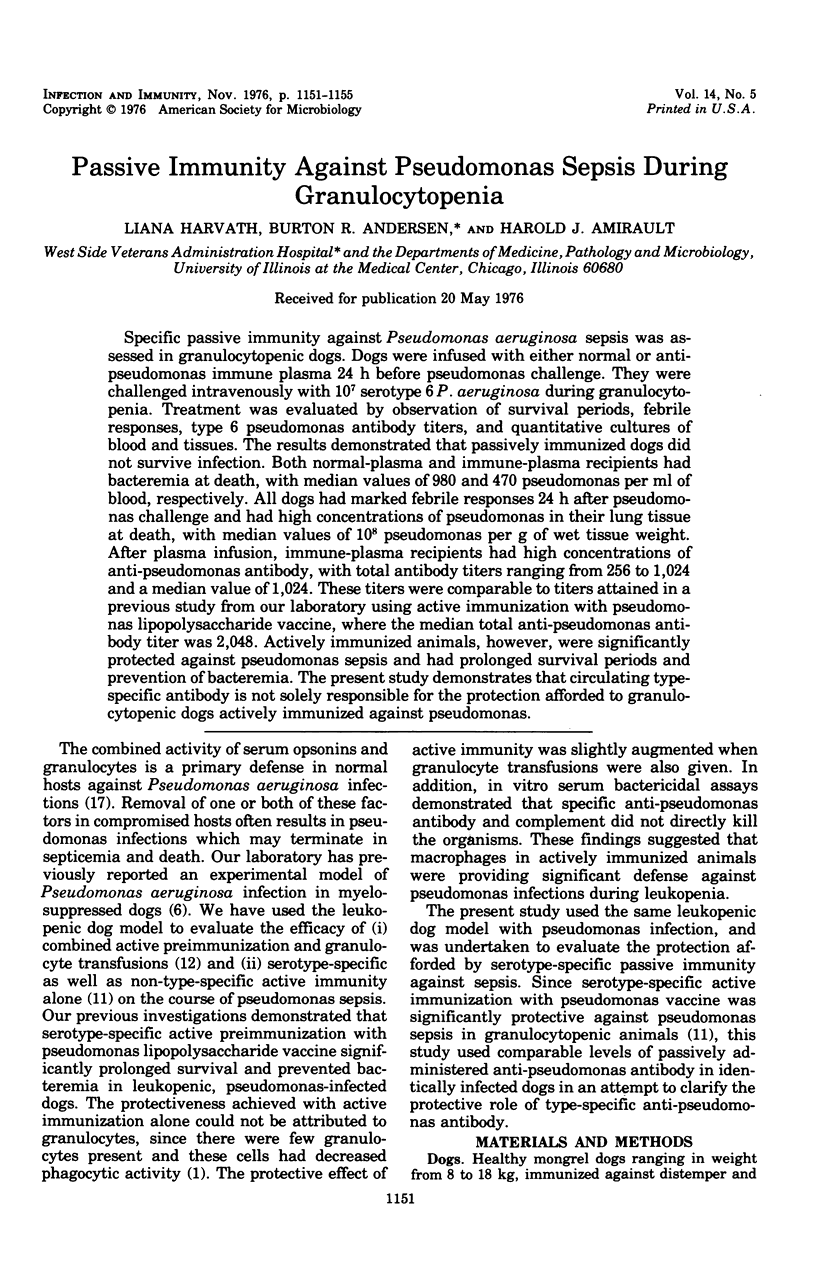
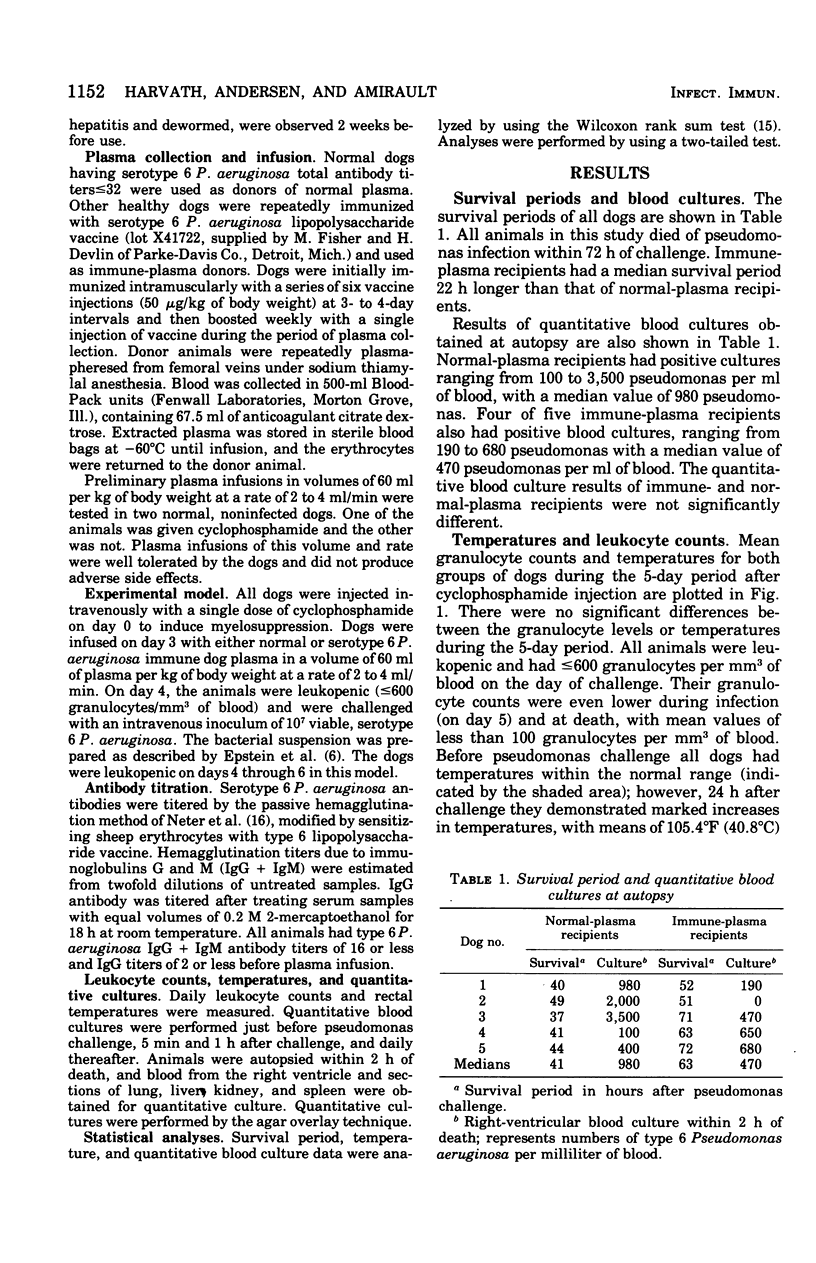
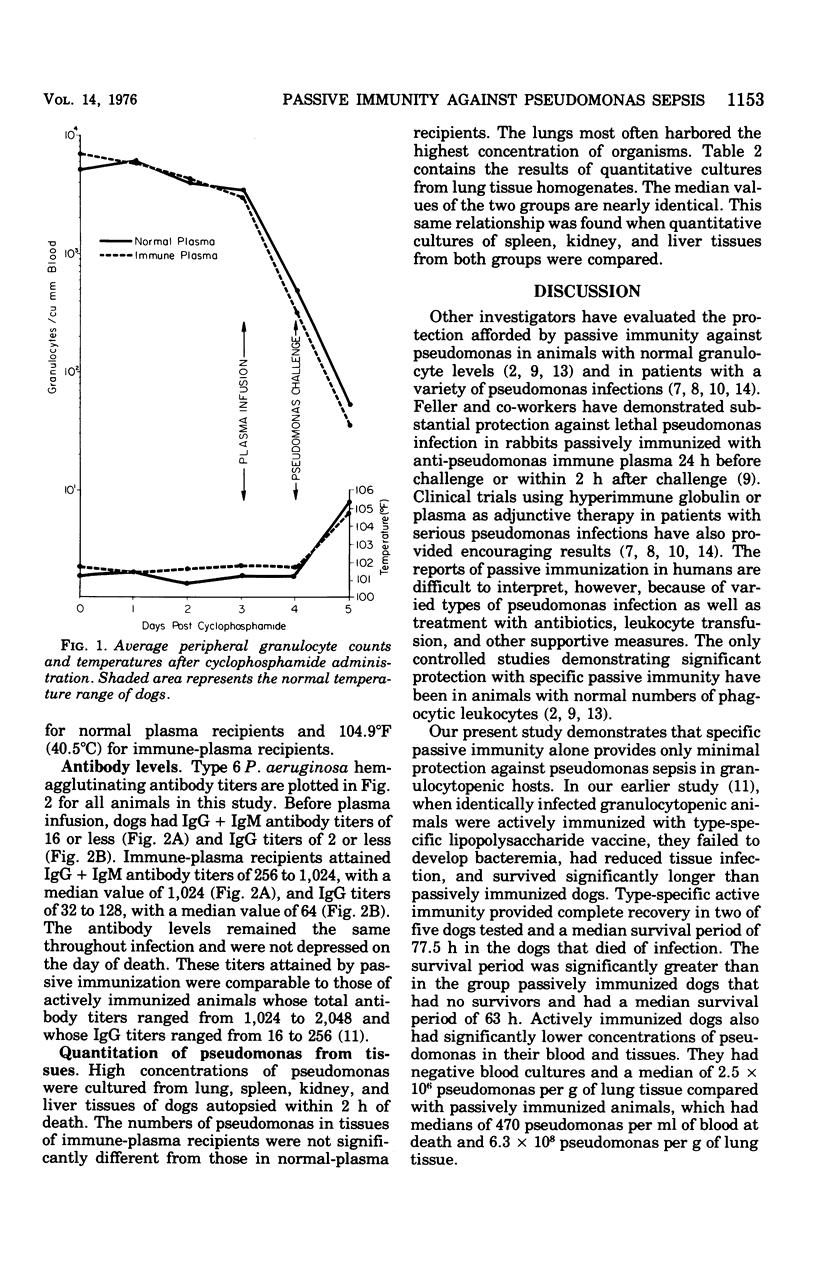
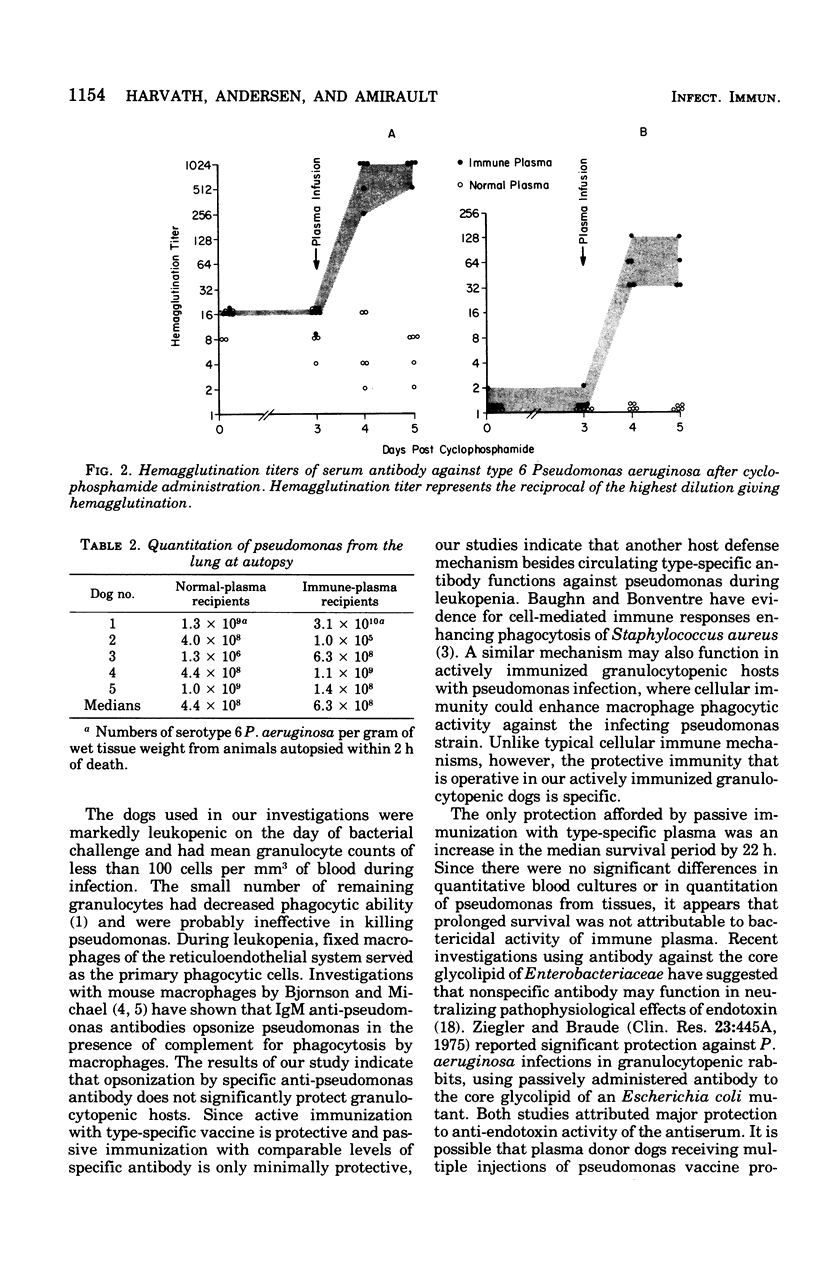
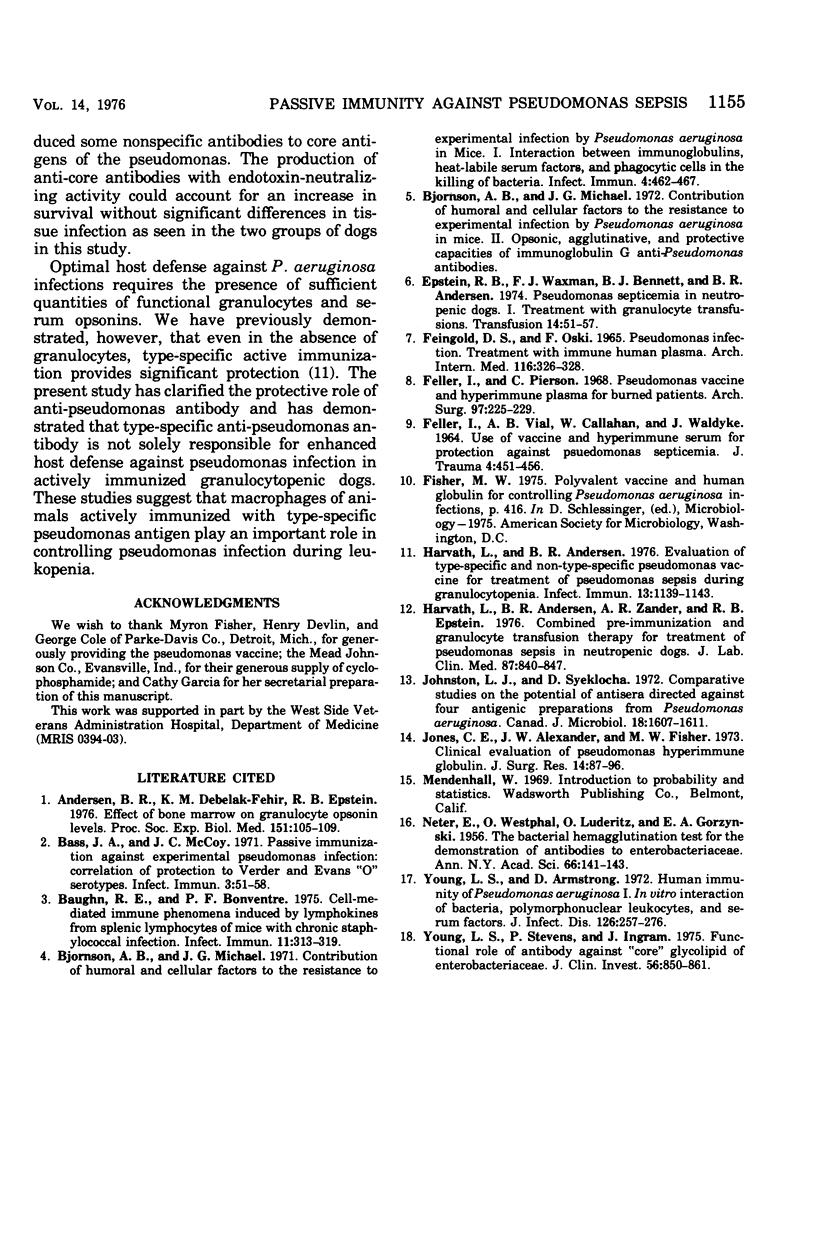
Selected References
These references are in PubMed. This may not be the complete list of references from this article.
- Andersen B. R., Debelak-Fehir K. M., Epstein R. B. Effect of bone marrow suppression on granulocyte opsonin levels. Proc Soc Exp Biol Med. 1976 Jan;151(1):105–109. doi: 10.3181/00379727-151-39153. [DOI] [PubMed] [Google Scholar]
- Bass J. A., McCoy J. C. Passive immunization against experimental pseudomonas infection: correlation of protection to verder and evans "o" serotypes. Infect Immun. 1971 Jan;3(1):51–58. doi: 10.1128/iai.3.1.51-58.1971. [DOI] [PMC free article] [PubMed] [Google Scholar]
- Baughin R. E., Bonventre P. F. Cell-mediated immune phenomena induced by lymphokines from splenic lymphocytes of mice with chronic staphylococcal infection. Infect Immun. 1975 Feb;11(2):313–319. doi: 10.1128/iai.11.2.313-319.1975. [DOI] [PMC free article] [PubMed] [Google Scholar]
- Bjornson A. B., Michael J. G. Contribution of humoral and cellular factors to the resistance to experimental infection by Pseudomonas aeruginosa in mice. I. Interaction between immunoglobulins, heat-labile serum factors, and phagocytic cells in the killing of bacteria. Infect Immun. 1971 Oct;4(4):462–467. doi: 10.1128/iai.4.4.462-467.1971. [DOI] [PMC free article] [PubMed] [Google Scholar]
- Epstein R. B., Waxman F. J., Bennett B. T., Andersen B. R. Pseudomonas septicemia in neutropenic dogs. I. Treatment with granulocyte transfusions. Transfusion. 1974 Jan-Feb;14(1):51–57. doi: 10.1111/j.1537-2995.1974.tb04484.x. [DOI] [PubMed] [Google Scholar]
- FEINGOLD D. S., OSKI F. PSEUDOMONAS INFECTION. TREATMENT WITH IMMUNE PLASMA. Arch Intern Med. 1965 Sep;116:326–328. doi: 10.1001/archinte.1965.03870030006002. [DOI] [PubMed] [Google Scholar]
- FELLER I., VIAL A. B., CALLAHAN W., WALDYKE J. USE OF VACCINE AND HYPERIMMUNE SERUM FOR PROTECTION AGAINST PSEUDOMONAS SEPTICEMIA. J Trauma. 1964 Jul;4:451–456. doi: 10.1097/00005373-196407000-00002. [DOI] [PubMed] [Google Scholar]
- Feller I., Pierson C. Pseudomonas vaccine and hyperimmune plasma for burned patients. Arch Surg. 1968 Aug;97(2):225–229. doi: 10.1001/archsurg.1968.01340020089010. [DOI] [PubMed] [Google Scholar]
- GORZYNSKI E. A., LUDERITZ O., NETER E., WESTPHAL O. The bacterial hemagglutination test for the demonstration of antibodies to Enterobacteriaceae. Ann N Y Acad Sci. 1956 Aug 10;66(1):141–156. doi: 10.1111/j.1749-6632.1956.tb40113.x. [DOI] [PubMed] [Google Scholar]
- Harvath L., Andersen B. R. Evaluation of type-specific and non-type-specific pseudomonas vaccine for treatment of pseudomonas sepsis during granulocytopenia. Infect Immun. 1976 Apr;13(4):1139–1143. doi: 10.1128/iai.13.4.1139-1143.1976. [DOI] [PMC free article] [PubMed] [Google Scholar]
- Harvath L., Andersen B. R., Zander A. R., Epstein R. B. Combined pre-immunization and granulocyte transfusion therapy for treatment of pseudomonas septicemia in neutropenic dogs. J Lab Clin Med. 1976 May;87(5):840–847. [PubMed] [Google Scholar]
- Johnston L. J., Syeklocha D. Comparative studies on the protective potential of antisera directed against four antigenic preparations from Pseudomonas aeruginosa. Can J Microbiol. 1972 Oct;18(10):1607–1611. doi: 10.1139/m72-245. [DOI] [PubMed] [Google Scholar]
- Jones C. E., Alexander J. W., Fisher M. Clinical evaluation of Pseudomonas hyperimmune globulin. J Surg Res. 1973 Feb;14(2):87–96. doi: 10.1016/0022-4804(73)90014-0. [DOI] [PubMed] [Google Scholar]
- Young L. S., Armstrong D. Human immunity to Pseudomonas aeruginosa. I. In-vitro interaction of bacteria, polymorphonuclear leukocytes, and serum factors. J Infect Dis. 1972 Sep;126(3):257–276. doi: 10.1093/infdis/126.3.257. [DOI] [PubMed] [Google Scholar]
- Young L. S., Stevens P., Ingram J. Functional role of antibody against "core" glycolipid of Enterobacteriaceae. J Clin Invest. 1975 Oct;56(4):850–861. doi: 10.1172/JCI108164. [DOI] [PMC free article] [PubMed] [Google Scholar]


